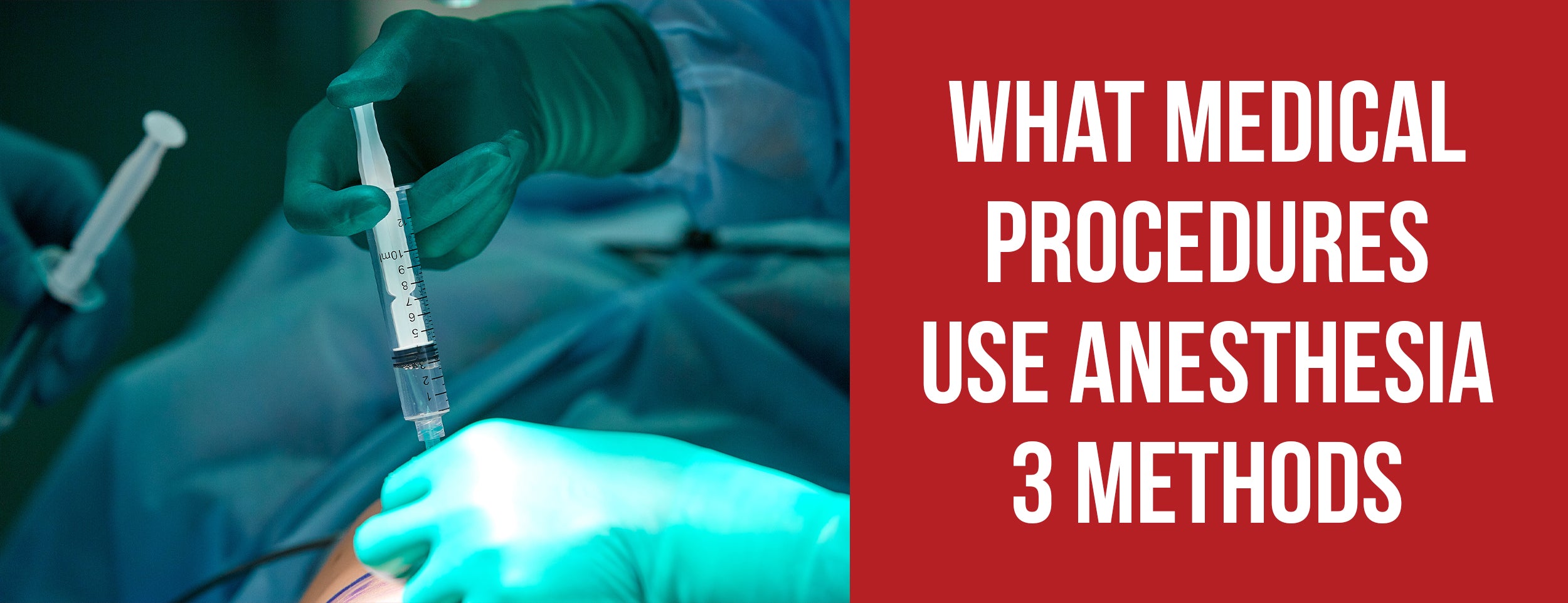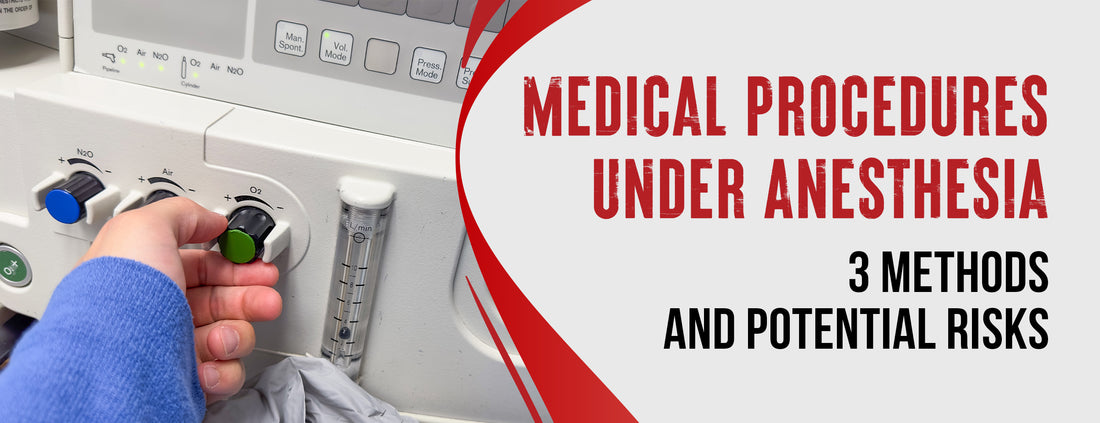Anesthesia is commonly used to facilitate a pain-free and comfortable experience for the patient.
General anesthesia affects the whole body. It makes you unconscious and unable to move. It is used during major surgeries like heart, brain, back, and organ transplants. Regional anesthesia may be used during childbirth, a Cesarean section (C-section), or minor surgeries.
This blog post will dive into what medical procedures commonly use anesthesia, the different types of anesthesia you may receive, the risks involved, and how you should prepare.
What Medical Procedures Use Anesthesia: 3 Methods

Modern medicine has made remarkable advancements, allowing precise and careful medical procedures. Anesthesia ensures patient comfort and safety during surgeries, diagnostic tests, and pain management. Explore the 3 primary categories of procedures that require anesthesia in this section.
Surgical Procedures
Surgical interventions are complex and require patients to be numb, enabling surgeons to work with precision. Anesthesia is crucial for ensuring minimal pain or discomfort during these procedures. Here are some notable surgeries that necessitate anesthesia:
- Cardiovascular Surgery: Delicate surgeries involving the heart and blood vessels require anesthesia, enabling surgeons to perform intricate procedures precisely. Common examples include coronary artery bypass grafting (CABG), valve repair or replacement, and heart transplant surgeries.
- Neurosurgery: Procedures involving the nervous system necessitate precise anesthesia control to minimize movement and facilitate surgical access. Neurosurgical interventions encompass brain surgery, spinal cord surgery, and procedures to address neurological conditions.
- Orthopedic Surgery: Anesthesia is essential for orthopedic procedures to ensure patients remain still and pain-free. Joint replacements, spinal surgeries, and fracture repairs fall within the domain of orthopedic surgery.

Diagnostic Procedures
Diagnostic procedures offer valuable insights into patient health, aiding in early detection and treatment of conditions. Anesthesia is used to enhance patient comfort and cooperation. Noteworthy anesthesia procedures include:
- Endoscopy: Anesthesia is used to ease discomfort during endoscopic examinations, such as upper gastrointestinal and colonoscopies, which involve visualizing the digestive tract.
- Colonoscopy: This procedure involves examining the colon and necessitates anesthesia to ensure patient relaxation and cooperation.
- Bronchoscopy: Anesthesia enables patients to undergo bronchoscopy, a procedure involving the inspection of the airways and lungs, with minimal discomfort.
Pain Management Procedures
For individuals grappling with chronic pain, various pain management procedures offer relief and improved quality of life. Anesthesia is utilized in these procedures to alleviate discomfort and facilitate successful outcomes. Notable pain management procedures requiring anesthesia include:
- Epidural Steroid Injections: Employed to manage spinal pain, anesthesia is utilized during epidural steroid injections to ensure patient comfort and precise needle placement.
- Nerve Blocks: Anesthesia accompanies nerve block procedures, injecting anesthetic agents to numb specific nerves and ease localized pain.
- Radiofrequency Ablation: This procedure, aimed at interrupting pain signals, requires anesthesia to enhance patient comfort while applying heat to targeted nerves.
Medical Procedures that Use Anesthesia: Potential Risks
Anesthesia carries risks and side effects. Administering anesthesia requires balancing medical goals with patient safety and comfort. Let's learn more about its risks and side effects:
Allergic Reactions

Anesthesia agents, though meticulously selected and administered, can trigger allergic reactions in rare instances. These reactions, while uncommon, necessitate vigilant monitoring and swift intervention. Common manifestations include:
- Skin Rashes or Hives: An allergic response may manifest as redness, itching, or raised welts on the skin, indicating an immunological reaction.
- Respiratory Distress: Wheezing, shortness of breath, or even anaphylaxis (a severe allergic reaction) can occur, requiring immediate medical attention.
- Cardiovascular Changes: Allergic reactions might lead to heart rate or blood pressure changes, necessitating careful monitoring and intervention.
Nausea and Vomiting
Post-anesthesia nausea and vomiting are potential side effects, especially after surgeries or procedures requiring more profound levels of anesthesia. Though temporary discomforts can hinder the recovery process:
- PONV (Post-Operative Nausea and Vomiting): The body's response to anesthesia can result in an unsettled stomach, leading to episodes of nausea and vomiting.
- Dehydration and Weakness: Prolonged nausea and vomiting can lead to dehydration, weakness, and delayed recovery.
Delirium and Confusion
Anesthesia may trigger turmoil or confusion, particularly in older adults. This state of cognitive disturbance can be disorienting and distressing:
- Post-Anesthesia Cognitive Dysfunction (PACD): Short-term confusion, memory lapses, or difficulty concentrating may occur, usually resolving within a few days.
- Preexisting Conditions: Individuals with preexisting cognitive conditions may be more susceptible to prolonged mental effects.
Damage to Teeth or Mouth

Anesthesia frequently requires the use of instruments and equipment that can unintentionally result in minor harm to oral structures, particularly during intubation or extubation procedures.
- Tooth Damage: Anesthesia tubes may chip or damage teeth, highlighting the importance of proper intubation techniques.
- Lip or Mouth Irritation: Equipment in the mouth may lead to temporary irritation or soreness in the lips, tongue, or cheeks.
Medications under Anesthesia: Preparation
Every medical procedure that requires anesthesia must be prepared for anesthesia. The risks associated with anesthesia can be minimized by taking proper precautions. We will provide you with a comprehensive guide on preparing for anesthesia in this article.
Medications and Supplements to Avoid
Anesthesia can interact adversely with certain medications and supplements, causing complications like high blood pressure, heart failure, and excessive bleeding. To mitigate risks, inform your anesthesiologist about your drugs and supplements. Here are some to avoid before anesthesia:
- Blood thinners such as aspirin, warfarin, and heparin.
- Herbal supplements such as Ginkgo biloba, garlic, and ginger.
- Vitamin E and fish oil supplements.
- Anti-inflammatory drugs such as Advil and Motrin.
You should inform your anesthesiologist if you are taking any of these medications or supplements so that he/she can adjust your anesthesia accordingly.

Fasting Instructions
Stomach contents entering the lungs during anesthesia, known as aspiration, can be minimized by fasting. Aspiration may result in severe respiratory issues and even death. Follow these fasting instructions before anesthesia:
- Only eat or drink something at least eight hours before your procedure.
- Inform your anesthesiologist if you have had anything to eat or drink before the procedure, as it may change the course of the anesthesia.
- If breastfeeding, you should stop breastfeeding at least four hours before the procedure.
Blood Tests and Medical History Review
Your anesthesiologist will review your medical history and conduct blood tests before administering anesthesia to assess your suitability for the procedure. Here are some of the evaluations your anesthesiologist may perform:
- Blood pressure test.
- Blood sugar test.
- Other blood tests to check your liver, kidney function, and electrolyte balance.
- Review of your medical history, including allergies and previous surgeries.
Conclusion
Anesthesia has come a long way since its modern use began in the mid-1800s. Patients who have received anesthesia report improved comfort, less pain, and reduced anxiety, making it an essential aspect of modern medicine.
While anesthesia disruptions are rare, it is necessary to understand its risks and side effects and what to expect before and after the procedure. By doing so, you can take an active role in your health care. Do not hesitate to ask your doctor or anesthetist if you have any questions. They will be happy to help you understand the process better.













![13 Top Anesthesia Side Effects & Potential Risks [covered]](http://drnumb.com/cdn/shop/articles/shutterstock_1781191736_1.jpg?v=1693284851)

